New Jersey makes a relatively strong effort to fund its schools, but many school districts remain chronically underfunded according to state law. This underfunding manifests itself in a variety of ways, including less competitive teacher wages, lower test scores, and larger class sizes.[1]
School underfunding, however, has other consequences that aren’t always immediately apparent. Curricular offerings in underfunded schools are less expansive, as fewer teachers are available for instruction in the arts, physical education, and foreign languages. These schools have proportionally fewer administrators and support staff, and their staffs have less experience. These disparities lead to meaningful differences in the education students receive.
What follows is an analysis of New Jersey Department of Education (NJDOE) data, which reveals that students in underfunded districts are receiving a less rich educational experience, in both content and resources, than those in better-funded districts. What’s worse, students of color are more likely to be in underfunded schools than white students.[2]
Background: Disparities in School Funding
New Jersey’s school funding law, the School Funding Reform Act of 2008 (SFRA), sets funding targets for the state’s school districts based on their needs and capacity to raise local tax revenue. The law is premised on the well-established finding that students in poverty, English language learners, and those with learning disabilities require more funding to equalize their education opportunities. Districts enrolling many of these students tend to have low property values; consequently, their ability to raise local revenues is not as large as in more affluent districts. The state, therefore, targets more school aid at these districts to provide all students with an adequate education.
Unfortunately, the state has never fully funded the SFRA. As a result, many districts in New Jersey must make do with revenues that are less than what the state’s law says they need. In a series of reports from 2020, NJPP documented the chronic underfunding of certain school districts in New Jersey.[3] The reports conclude that these districts enroll more Black and Hispanic/Latinx students than districts with adequate funding and that these districts tend to have lower test scores and less competitive teacher wages.
There is good reason to believe that the funding targets set for SFRA are too low to meet current state standards.[4] And state aid is only a partial solution to inequities in local school tax capacity, which are driven by patterns of disinvestment and systemic racism. This said, the amount a district spends under or over its per pupil SFRA target is a useful way to compare relative spending between districts, and the consequences of those differences.
Comparing School Districts with Different Funding
The analysis below uses the same methodologies described in previous reports to determine how much New Jersey school districts spend, per pupil, over or under their SFRA target. The districts are classified into four categories:
- Severely Underfunded: $5,000 or more below SFRA target.
- Underfunded: Below SFRA target, but not more than $5,000.
- Adequately Funded: At or above SFRA target, but not by more than $5,000.
- Highly Funded: More than $5,000 above SFRA target.
New Jersey school districts enroll students in various grade levels. For example, some districts enroll all K-12 students, some only K-8, some only high school, etc. To make comparisons more relevant, districts are only compared to others with the same grade level enrollments.[5]
Staff per 100 Students
Highly funded districts not only pay more competitive wages but also employ more staff per student. Severely underfunded K-12 districts, for example, only employ an average of 9.4 staff members per 100 students, as opposed to 12.9 staff per 100 students in highly funded districts.
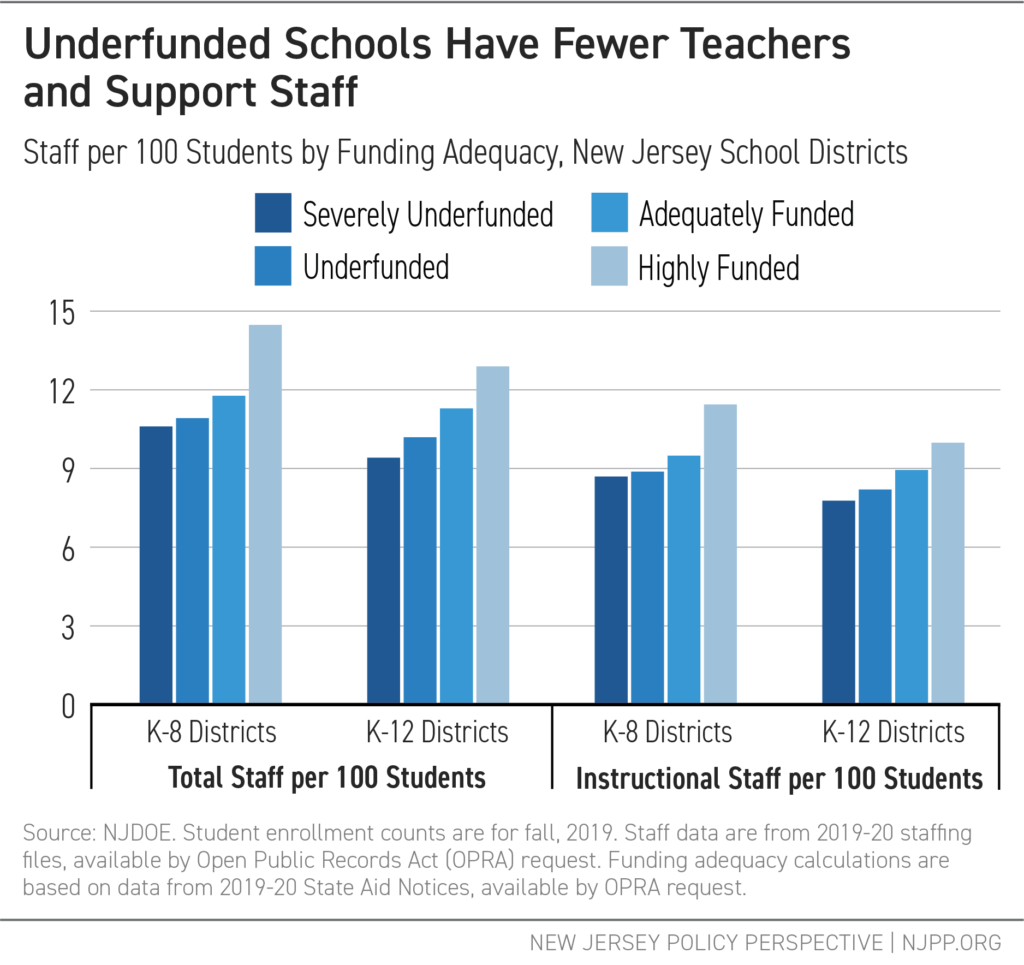
Highly funded school districts also employ more administrators and support staff than underfunded districts. As an example: K-8 districts that are severely underfunded have almost half the support staff per 100 students that highly funded districts have. Support staff include librarians, counselors, therapists, nurses, and other certificated school staff who provide vital student services outside the classroom.
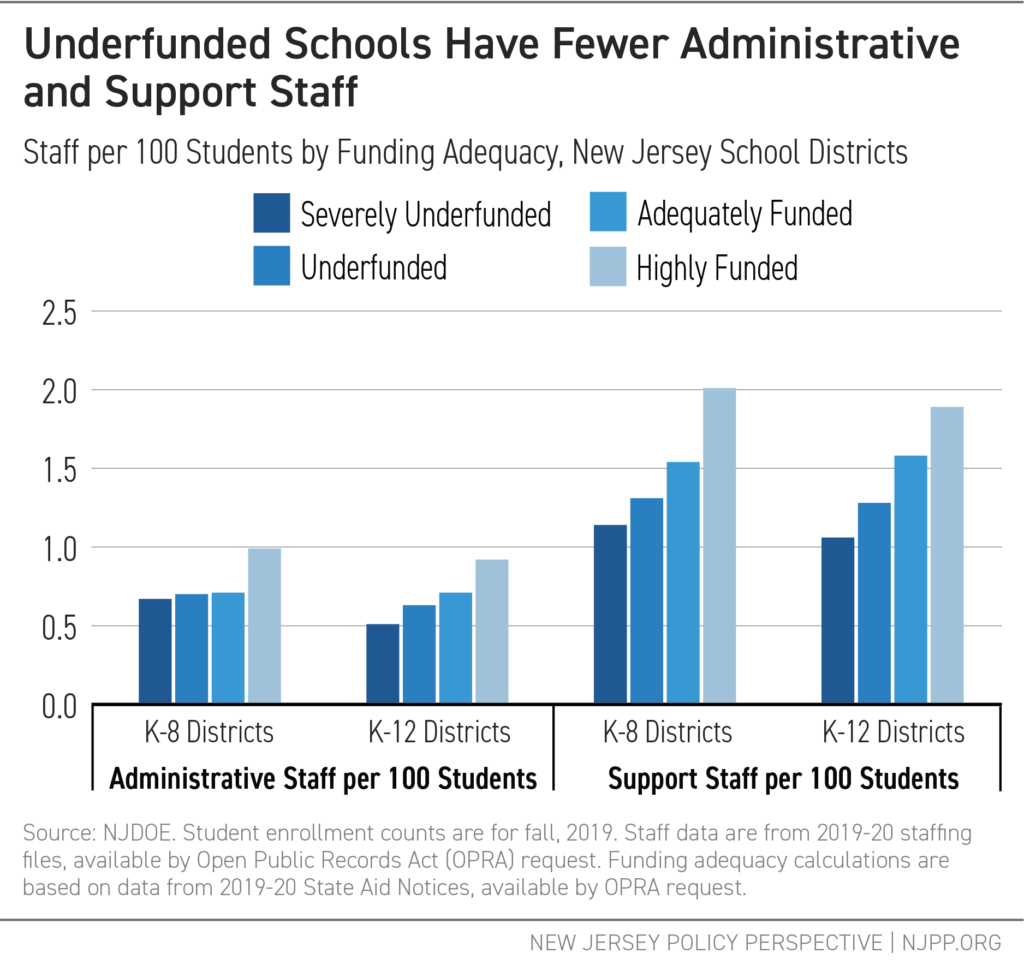
Staff In Non-Tested Subjects
New Jersey’s Student Learning Standards require students to have access to a broad, rich curriculum in a variety of subjects. [6] These include the arts, physical education, and foreign languages. These subjects are not tested like math and English Language Arts (ELA), but are still critical to student learning.
Unfortunately, students in underfunded schools do not have the same access to instruction in these areas as students in adequately funded schools. Staff members in underfunded schools have greater student “loads,” or the number of students in the district per teacher. More students per arts staff, for example, means larger class sizes, reduced instructional time, or fewer electives in the arts available to students.
Student loads are much greater for teachers of the arts in underfunded districts.[7] In severely underfunded K-12 districts, for example, there is one arts teacher for every 495 students. Meanwhile, in highly funded districts, there is one arts teacher for every 320 students. In severely underfunded K-8 districts, there are 708 students for each music teacher as compared to 225 students per music teacher in highly funded districts.
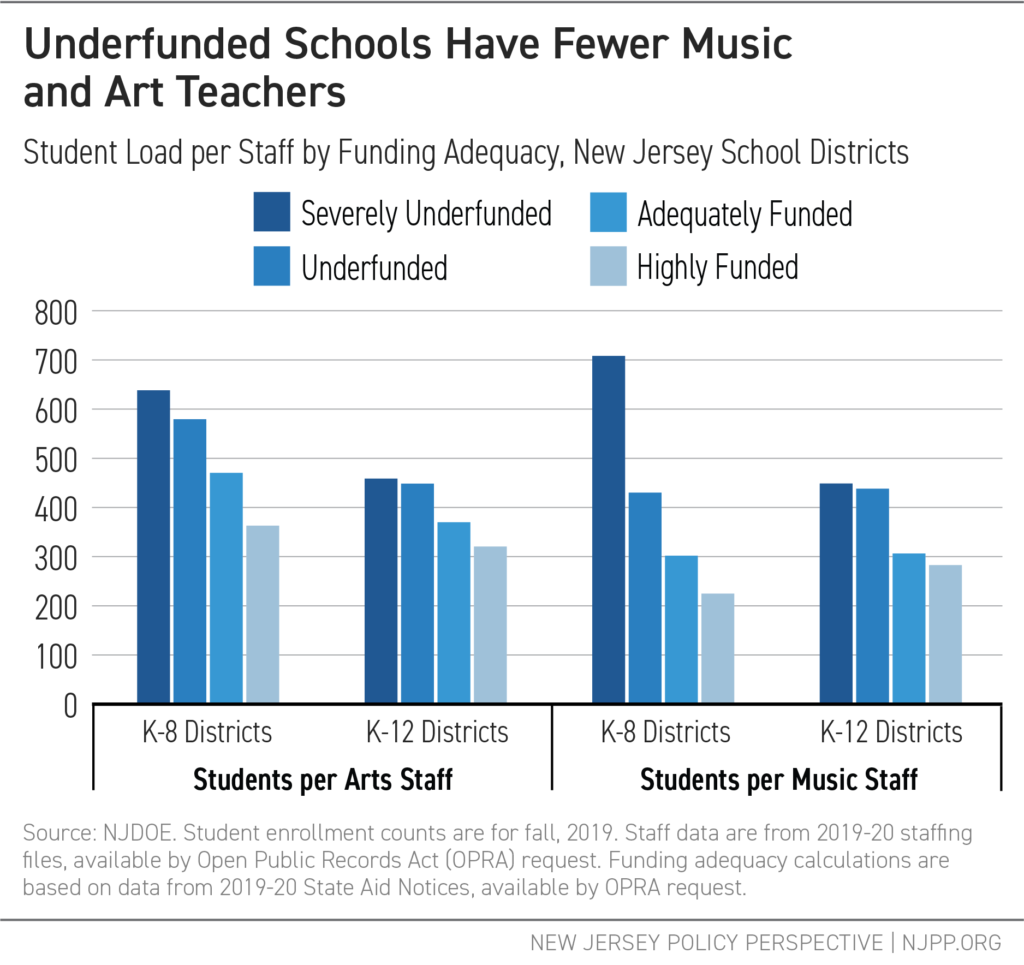
The same pattern generally applies to physical education (PE) teachers and school nurses. Highly funded K-12 districts have one PE teacher for every 165 students; severely underfunded districts have one PE teacher for every 231 students. The pattern holds for school nurses, except for nurses in highly funded K-12 districts. Simply put, more funding allows for more school staff to keep children healthy.
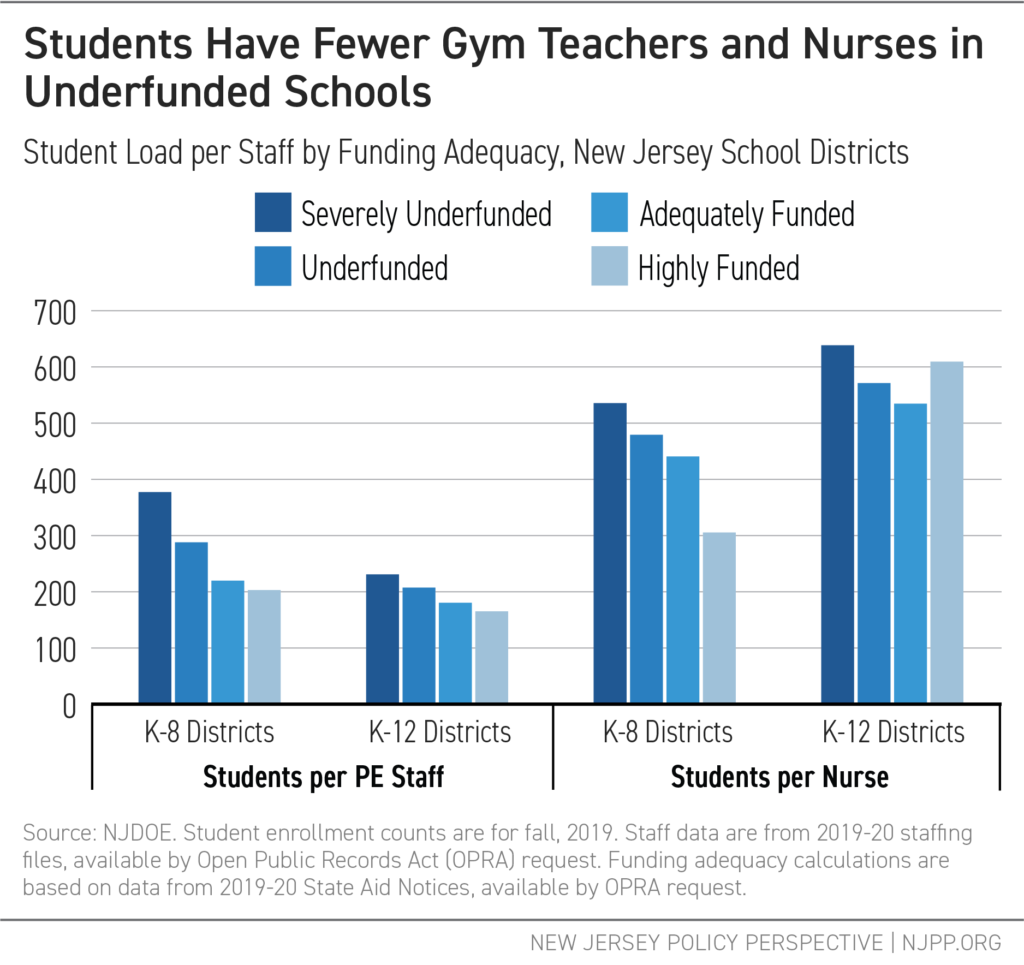
The same pattern applies to subjects like foreign language, social studies, and science.[8] Teachers of these subjects in K-12 districts tend to have smaller student loads when their district’s funding adequacy is greater.
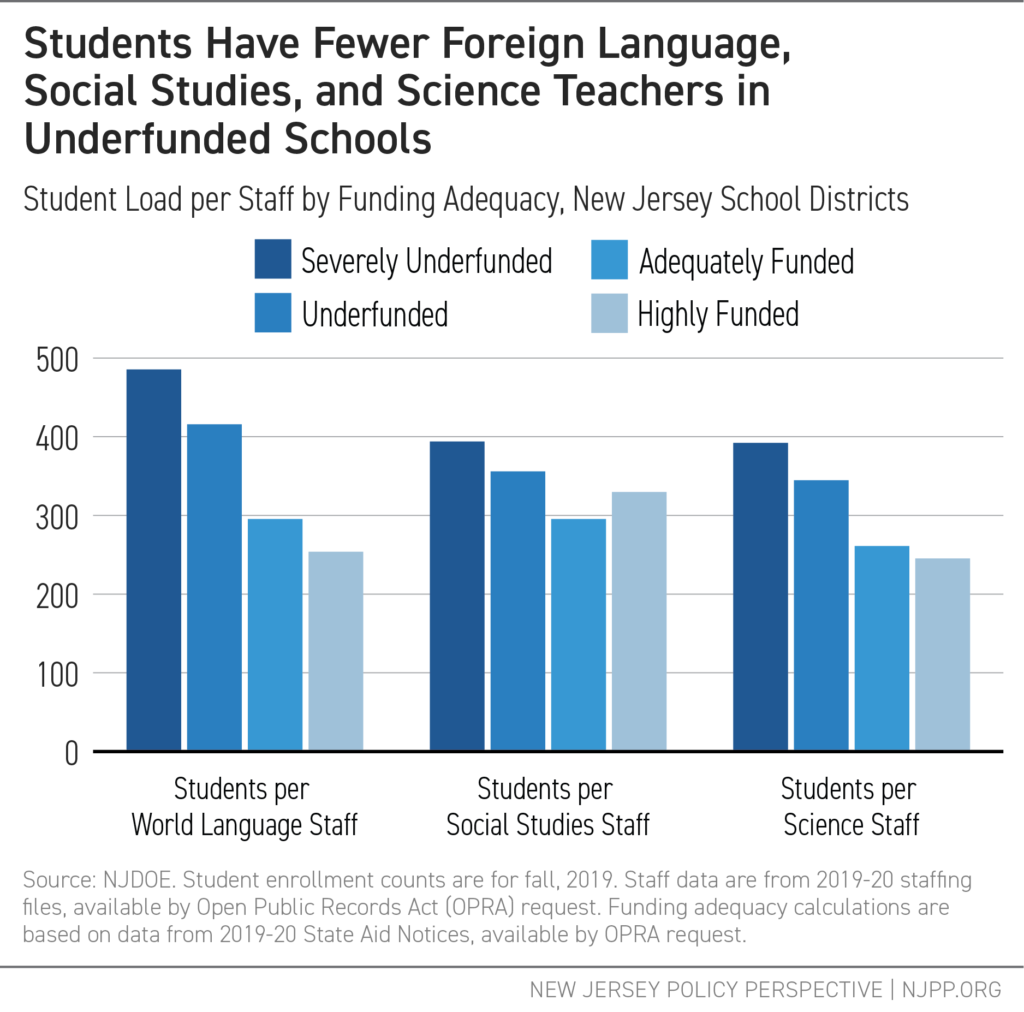
School Staff Characteristics
A significant body of evidence shows that teachers improve in their effectiveness as they gain in experience.[9] While many of those gains take place within the first three years of a teacher’s career, gains in effectiveness are still found even several decades later. Average teacher experience, then, is an important marker of school quality.
Teachers in New Jersey’s underfunded schools have substantially less experience than teachers in its adequately funded schools. On average, a teacher in a highly funded K-8 district will have over three years more experience than a teacher in a severely underfunded district. Teachers in highly funded K-12 districts have over two years more experience, on average, than those in severely underfunded districts.
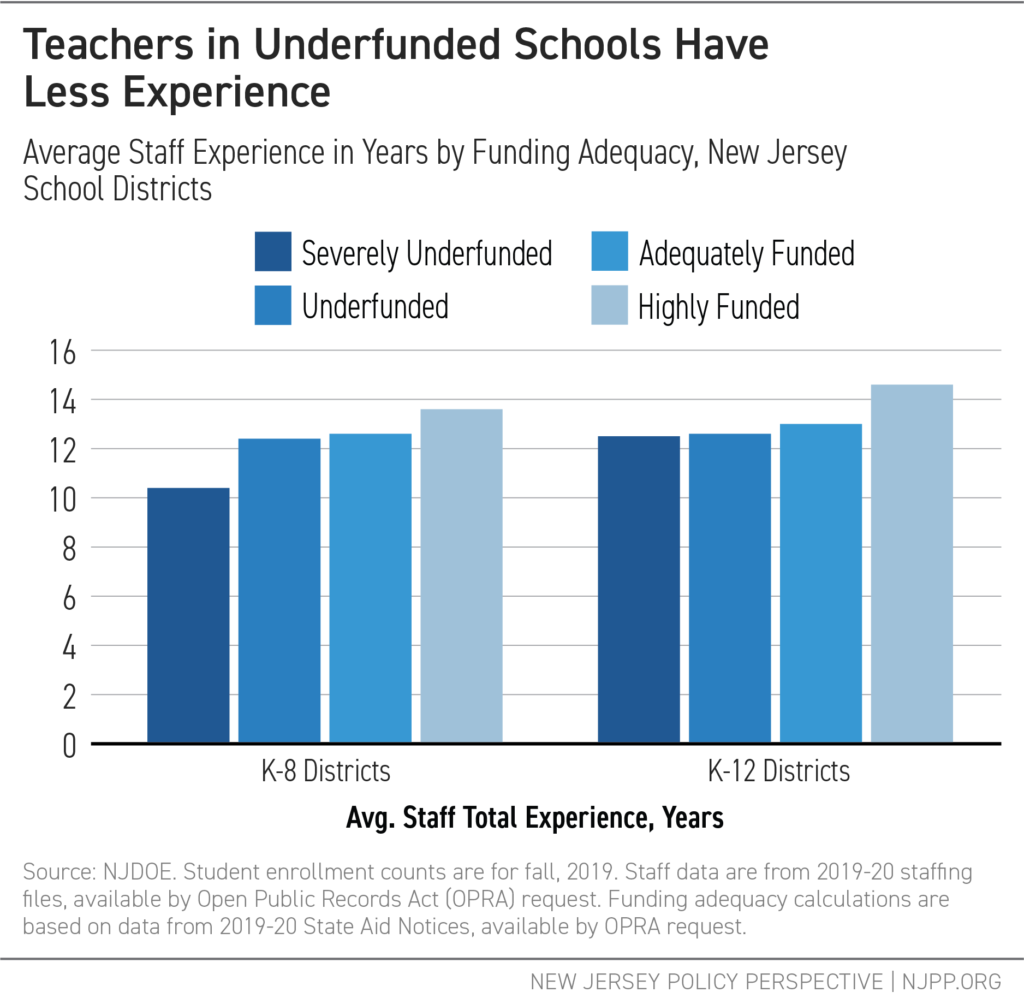
The percentage of teachers with less than three years of experience is greater in severely underfunded districts; again, teachers gain the most in effectiveness in their first three years. School staff in highly-funded schools are also more likely to have advanced degrees. All of this suggests highly funded districts are at an advantage in recruiting and retaining the most effective and highly educated teachers.
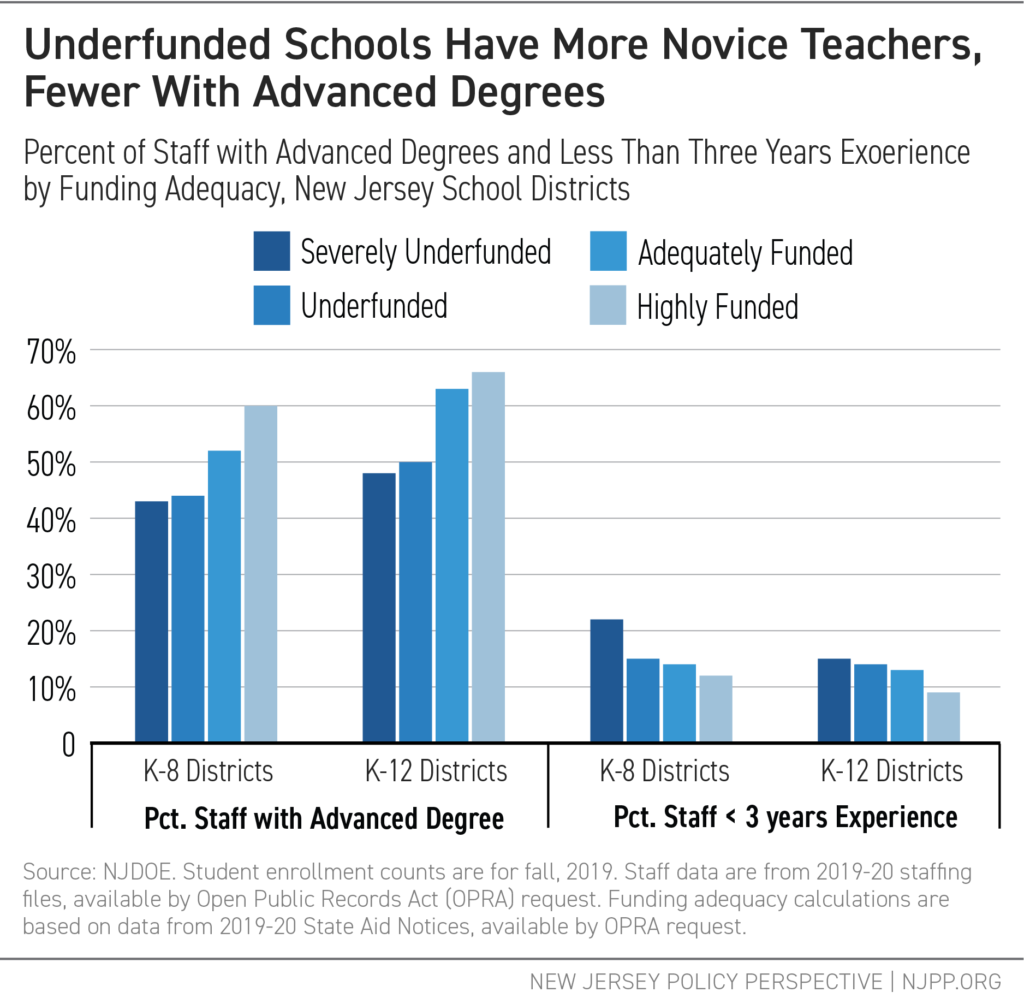
Conclusion
Across the state, students in underfunded districts attend schools that have fewer teachers to deliver a broad, rich curriculum than students in adequately funded districts. These students are also more likely to have teachers who are inexperienced and do not hold an advanced degree.
Students enrolled in districts that the state considers adequately funded are also at a disadvantage compared to students in highly funded districts. Students in the most affluent districts go to schools with proportionally more teachers of music, arts, foreign language, science, and PE. Their teachers are more likely to have an advanced degree and are more experienced. These students receive an education that is, put simply, better.
So, while fully funding SFRA is an important step toward equalizing educational opportunity, it is not, by itself, enough. Every child deserves a rich curriculum as outlined by New Jersey learning standards; every child deserves the same access to highly educated and experienced teachers. Recalibrating SFRA to address the disparities outlined here will be necessary to provide the education all children should receive.
End Notes
[1] For a full discussion of New Jersey school funding, see: Mark Weber & Bruce Baker (2020), School Funding in New Jersey: A Fair Future for All. New Jersey Policy Perspective; Trenton, NJ. https://www.njpp.org/publications/report/school-funding-in-new-jersey-a-fair-future-for-all/
[2] Weber and Baker (2020), School Funding in New Jersey: A Fair Future for All; Part 3: The School Funding Reform Act – 2020 Update. New Jersey Policy Perspective; Trenton, NJ. https://www.njpp.org/wp-content/uploads/2020/11/NJPP-School-Funding-in-New-Jersey-A-Fair-Future-for-All-Part-3.pdf
[3] Weber and Baker (2020).
[4] Weber and Baker (2020). Upcoming work will further explore this issue, and the intersection of racism and school funding.
[5] This analysis excludes regional high schools as the numbers of these districts in each of the funding categories is small, making generalizations difficult. Also excluded are vo-tech schools, special services districts, and charter schools.
[6] https://www.nj.gov/education/cccs/
[7] In this analysis, “arts” teachers include teachers of visual arts, dance, and drama.
[8] This part of the analysis excludes K-8 districts as much more of the instruction in these subjects in those districts is taught by staff with general elementary certificates, making comparisons difficult.
[9] Mark Weber (2019). In Brief: New Jersey’s Teacher Workforce, 2019. New Jersey Policy Perspective; Trenton, NJ. https://www.njpp.org/publications/report/in-brief-new-jerseys-teacher-workforce-2019-diversity-lags-and-wage-gap-persists/

